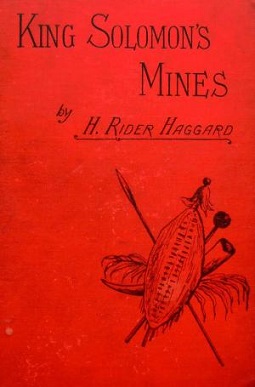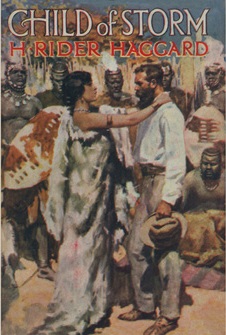
Sir Henry Rider Haggard was an English writer of adventure fiction romances set in exotic locations, predominantly Africa, and a pioneer of the lost world literary genre. He was also involved in land reform throughout the British Empire. His stories, situated at the lighter end of Victorian literature and including the eighteen Allan Quatermain stories beginning with King Solomon's Mines, continue to be popular and influential.

King Solomon's Mines is an 1885 popular novel by the English Victorian adventure writer and fabulist Sir H. Rider Haggard. It tells of an expedition through an unexplored region of Africa by a group of adventurers led by Allan Quatermain, searching for the missing brother of one of the party. It is one of the first English adventure novels set in Africa and is considered to be the genesis of the lost world literary genre. It is the first of fourteen novels and four short stories by Haggard about Allan Quatermain. Haggard dedicated this book to his childhood idol Sir Humphry Davy.

Allan Quatermain is the protagonist of H. Rider Haggard's 1885 novel King Solomon's Mines, its one sequel Allan Quatermain (1887), twelve prequel novels and four prequel short stories, totalling eighteen works. An English professional big game hunter and adventurer, in film and television he has been portrayed by Richard Chamberlain, Sean Connery, Cedric Hardwicke, Patrick Swayze and Stewart Granger among others.
The lost world is a subgenre of the fantasy or science fiction genres that involves the discovery of an unknown Earth civilization. It began as a subgenre of the late-Victorian adventure romance and remains popular into the 21st century.

The World's Desire is a fantasy novel first published in 1890 and written by H. Rider Haggard and Andrew Lang. It was published in paperback by Ballantine Books as the fortieth volume of the Ballantine Adult Fantasy series in January 1972.

Ayesha, the Return of She is a gothic-fantasy novel by the English Victorian author H. Rider Haggard, published in 1905 as a sequel to his 1887 novel She. Chronologically, it is the final novel of the Ayesha and Allan Quatermain series. It was serialised in issues 120 to 130 of the Windsor Magazine, where it was illustrated by Maurice Greiffenhagen.

Cleopatra: Being an Account of the Fall and Vengeance of Harmachis is an adventure novel written by English author H. Rider Haggard and first printed in 1889 by Longmans. Cleopatra mixes historical action with supernatural events, and could be described as a historical fantasy novel.

She and Allan is a novel by H. Rider Haggard, first published in 1921. It brought together his two most popular characters, Ayesha from his 1887 novel She, and Allan Quatermain from his 1885 novel King Solomon's Mines. Umslopogaas from Nada the Lily (1892) also appears in the novel as a major character. Along with the other three novels in the Ayesha series, She and Allan was adapted into the 1935 film She. She and Allan is the third story in the Ayesha series and the fifteenth in the Quatermain series.

Nada the Lily is an historical novel by English writer H. Rider Haggard, published in 1892. Inspired by Haggard's time in South Africa (1875–82). It was illustrated by Charles H. M. Kerr.

Child of Storm is a 1913 novel by H. Rider Haggard featuring Allan Quatermain. The plot is set in 1854-56 and concerns Quatermain hunting in Zululand and getting involved with Mameena, a beautiful African girl who causes great turmoil in the Zulu kingdom. It is the sixth novel, and the tenth story overall, in the Quatermain series.

Allan and the Ice-Gods is a novel by H. Rider Haggard featuring his recurring character Allan Quatermain, based on an idea given to Haggard by Rudyard Kipling. The story details Quatermain's past life regression to a Stone Age ancestor and the various adventures involved.

Benita: An African Romance is a novel by H. Rider Haggard.

The Ghost Kings is a 1908 mystery-adventure novel by H. Rider Haggard, set on the borders of Zululand in Africa.

The Yellow God: An Idol of Africa is a 1908 novel by H Rider Haggard.

The Ancient Allan is a novel by H. Rider Haggard. It is the fourteenth of the eighteen overall stories Haggard wrote about the hunter Allan Quatermain, and the tenth novel in the series.

Red Eve is a historical novel with fantasy elements, by British writer H. Rider Haggard, set in the reign of Edward III. Red Eve depicts the Battle of Crécy and the Black Death, and also features a supernatural personification of Death called Murgh.

Heu-Heu; or, The Monster is a novel by H. Rider Haggard. Allan Quatermain tells the story of a monster in Rhodesia. Heu-Heu is the twelfth of the fourteen novels in the Quatermain series and the sixteenth of the eighteen overall stories.

The Treasure of the Lake is one of the two posthumously published novels by H. Rider Haggard featuring Allan Quatermain. In publication order it is the seventeenth of the eighteen Allan Quatermain stories.
Allan Quatermain is an 1887 novel by H. Rider Haggard. It is the sequel to Haggard's 1885 novel King Solomon's Mines. Allan Quatermain is the second novel and fourth overall story in the eighteen-part series of the same name, though chronologically it is the final entry.

















